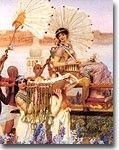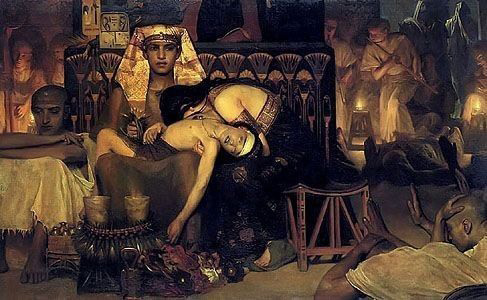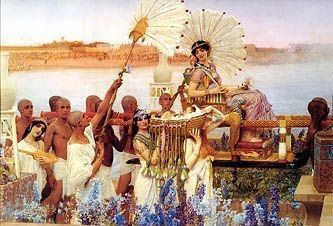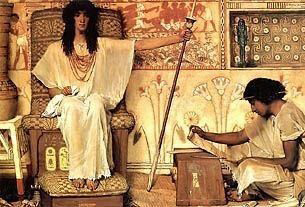|
SIR LAWRENCE | |||||
Lawrence Alma-Tadema Gallery of Royalty Free Images Art Works in High Resolution. Art and Artist study of Tadema biblical paintings.
Always Royalty Free |
Alma-Tadema is credited with having solved "the problem of the picture of antique manners in the most authentic fashion in the province of painting. He has peopled the past, rebuilt its towns, refurnished its houses and rekindled the flame upon the sacrificial altars." In other words, this famous Dutch painter, who was born in Holland in 1836 and, settling in London, became a naturalized Englishman in 1873, called to life amid London smoke and fog the sacrifices of Pompeii and Herculaneum, and leads us pictorially through the streets of old Athens, reconstructing the temples, altars and dwellings, the shops of the butchers, bakers and fishmongers, just as they once were. Alma-Tadema first had the Dutch painter Leys for a master at the Academy of Fine Arts, Antwerp. He was then sixteen, and almost immediately exhibited a preference for historical painting. Encouraged by his preceptor, he began with early French and Egyptian subjects, but it was not until 1863, when he first went to Italy, that he may be said to have discovered his archaeological mission. How the old Romans dressed, how their armies were equipped and attired, became the object of his painstaking study, as did everything that might enable him to bring antiquity back to life in so far as it lay in the power of his art. Muther records, "He explored the ruins of the temples, and he grew familiar with the privileges of the priests, the method of worship, of the sacrifices and of the festal processions. There was no monument of brass or marble, no wall painting, no pictured vase nor mosaic, no sample of ancient arts, of pottery, stone-cutting, or work in gold, that he did not study." In 1869 he sent his painting "The Pyrrhic Dance" to the Academy in London, where it was so well received that the painter decided to make his home in England. Indeed, London, for all its grime and fog, offered even a more favorable atmosphere for the art of Alma-Tadema than did that of his native land. Contributing materially to it were his home and studio surroundings, in a Pompeiian house which he built in the English metropolis, with "its dreamy vividarium, its great golden hall, its Egyptian decorations, its Ionic pillars, its mosaic floor, and its Oriental carpets. Everything needful to conjuring up the days of Nero and the Byzantine emperors." It was surrounded by a garden in the old Roman style, with a large conservatory planted with plane-trees and cypresses. All the celebrated marble benches and basins, the figures of stone and bronze, the tiger-skins and antique vessels and garments of his pictures, were to be found in this notable house in the midst of London. In their still-life his pictures are the record of immense archaeological learning which, with this artist, became intuitive vision, but his figures are the result of a healthy rendering of life. His drawing is generally pronounced good, his coloring faithful, but he is at times charged with a lack of sentiment. It is a visual pleasure of coloring, intelligent grouping, fine differentiation of textures and of stuffs that his pictures afford. In his long and successful career Alma-Tadema was the recipient of many great international honors. He died while staying at Wiesbaden in 1912. Navigation and Searching – Terms of Use – Contact Us |



